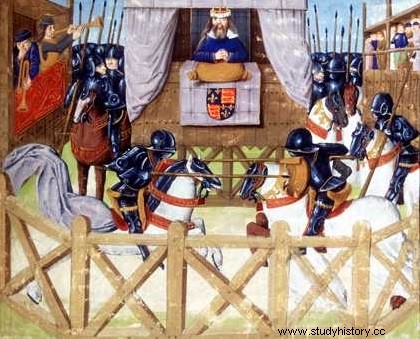 In the Middle Ages, the knight was a man-at-arms fighting on horseback, most often in the service of a king or a great feudal lord. The term chivalry evokes in our minds a whole dreamlike and fantastic universe that speaks to us of self-transcendence, honor, fidelity, gratuitousness and courtesy which literature, then cinema have largely echoed. Mounted on a powerful steed, wearing a helmet and caparisoned in steel, the knight , wielding the sword "thrust and size" proudly displays its colors. Beautiful, loyal, valiant and courageous, chivalry still testifies today to what the Middle Ages really were.
In the Middle Ages, the knight was a man-at-arms fighting on horseback, most often in the service of a king or a great feudal lord. The term chivalry evokes in our minds a whole dreamlike and fantastic universe that speaks to us of self-transcendence, honor, fidelity, gratuitousness and courtesy which literature, then cinema have largely echoed. Mounted on a powerful steed, wearing a helmet and caparisoned in steel, the knight , wielding the sword "thrust and size" proudly displays its colors. Beautiful, loyal, valiant and courageous, chivalry still testifies today to what the Middle Ages really were.
Chivalry, a Germanic origin
The cult of weapons asserted itself within Germanic societies which provided many recruits to the ending Roman Empire. For the Germans, to be free is to be in arms and the passage from youth to manhood is marked by a ritual described in a famous text by the Latin writer Tacitus:"custom dictates that no one take arms before the city recognized him capable. Then one of the chiefs, his father or those close to him decorate the young man with the shield and the “framee”:this is their toga, these are the first honors of their youth”.
Marc Bloch identifies the roots of medieval chivalry (initiatory warrior brotherhood) in the practices of early medieval Germanic societies.
Dungeons and the castle revolution
The words castrum and castellum designate buildings that remain until the end of the 10th th century on a modest scale. Simple wooden dungeons, they are built on a rocky escarpment, a loop of a river, the center of a marshy area... or in the plain, on a clod of earth. Thanks to the use of stone in 1050, the dungeon, which had become more resistant, had square towers pierced with arrow slits. Most of them had three floors:on the ground floor the storeroom for storing provisions; above a large room where the precious goods of the lord are piled up, then at the top a covered platform where the men in charge of the lookout stand guard.
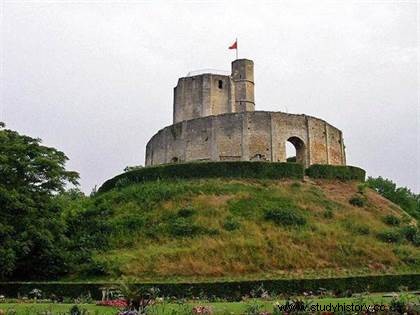 If the dungeon serves as a refuge in case of danger, the lord and his family lodge in the buildings surrounding it- here, surrounded by a protective palisade and a ditch. Next to the master's house are stables, workshops, kitchens and servants' huts. The word dungeon comes from dungio derived from dominus the Lord. The castle is held by a castellan lord with the right of ban (power of military command, police and justice) which he enforces thanks to a team of warriors grouped in garrison. These activists are permanent professional fighters, this is the novelty of the chivalry of the XI
e
century.
If the dungeon serves as a refuge in case of danger, the lord and his family lodge in the buildings surrounding it- here, surrounded by a protective palisade and a ditch. Next to the master's house are stables, workshops, kitchens and servants' huts. The word dungeon comes from dungio derived from dominus the Lord. The castle is held by a castellan lord with the right of ban (power of military command, police and justice) which he enforces thanks to a team of warriors grouped in garrison. These activists are permanent professional fighters, this is the novelty of the chivalry of the XI
e
century.
A dense castral network marks the landscape:Maine with eleven castles in 1050 had sixty-two in 1100, Poitou rose from three to thirty-nine in the XI e century; in Catalonia eight hundred fortresses are identifiable in 1050. This is what historians call the “castle revolution”. The number of motte castles in France is estimated at around ten thousand.
These constructions being a challenge to the central power, Charles the Bald tried to ban them in 864, arguing inconveniences for the inhabitants of the neighborhood but these, victims of insecurity, preferred suffer the constraints of the seigniorial power in place to benefit from the protections offered by the fortified places and the men-at-arms who occupy them.
The knights of the Middle Ages, a warrior aristocracy
In medieval society, the knight is the sword bearer, the one who has the right and the duty to be armed, he is the protector of the men and women of his community so that they can go about their business in peace. In Europe, carrying a weapon has been perceived since High Antiquity as the mark of those who claim their dignity by shedding their blood and risking their lives. The prestige of the weapon makes the wearer a special being who has specific rights and duties.
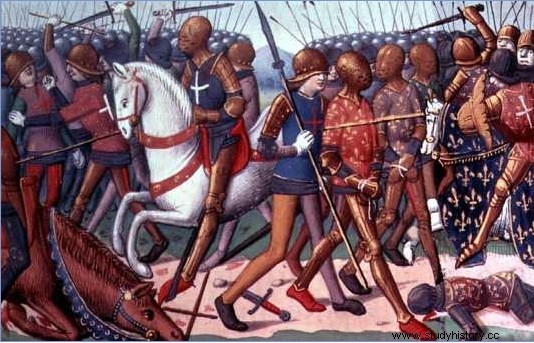 One finds among the knights princes, dukes, counts but also men of modest origins:serfs, peasants commoners who have distinguished themselves for their courage and loyalty to a warrior in danger. A number of songs of gesture relate these facts. These Castri militants are maintained and fed by the lord, they are part of his household.
One finds among the knights princes, dukes, counts but also men of modest origins:serfs, peasants commoners who have distinguished themselves for their courage and loyalty to a warrior in danger. A number of songs of gesture relate these facts. These Castri militants are maintained and fed by the lord, they are part of his household.
Others are "chased away", they receive land intended to provide for their maintenance. Ministerials, identifiable serf-knights, can achieve a social ascent (advantageous marriage for example). The cadets of lesser nobility must seek their fortune at the point of the sword, not being able to claim the paternal inheritance.
Knights have a vocation from the XI e century to integrate into the ranks of the nobility except for those already belonging to it. The fusion between knights and nobility took place later, it was not until the 13 e century in Lorraine, the 14 th in Alsace to see it, but from the 13 th century chivalry closed in on itself, the aristocracy wanting to reserve the privilege to its sons. The chivalry then presents itself as the community of noble warriors opposed to "foot soldiers" without faith or law.
Appears a professionalization of the fighter, the change of combat techniques requiring specialization. In the heavy cavalry the tactic is based on the sinking of the opposing front by rupture effect. The charge is done at a gallop, the spear wedged under the arm lowered horizontally unlike the throwing spear that can only be used once.
Arms of the knight in the Middle Ages
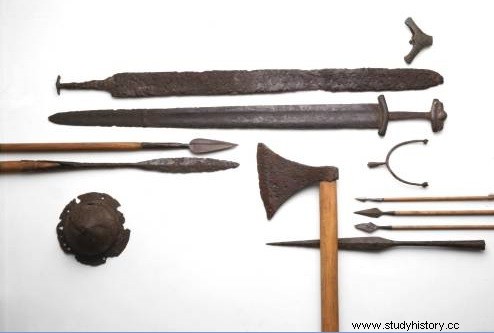 While javelins and pikes continue to be used by infantry, the lance of knights is very often cited in the literature (songs of lay gestures, novels) exalting the chivalrous life. This spear fitted with a wooden shaft lengthens gradually to reach four meters and weighs almost twenty kilos. A stop washer prevents the hand from slipping on impact.
While javelins and pikes continue to be used by infantry, the lance of knights is very often cited in the literature (songs of lay gestures, novels) exalting the chivalrous life. This spear fitted with a wooden shaft lengthens gradually to reach four meters and weighs almost twenty kilos. A stop washer prevents the hand from slipping on impact.
At XV e century a hook is fixed on the armor to join lance and cuirass in order to relieve the lance carrier (called knight-banneret) the weight of this one being able to be increased by the pennon and the sign or even the banner which allows to identify the fighter, to be a rallying point in the heart of the fray. Spear broken, sword must be drawn!
The most used offensive weapons are the spear and the sword, followed by axes, maces, flails and daggers. Among the latter ''mercy'' has an eloquent name:its short and thin blade can be inserted between the metal parts of the hauberk and the helm. The crossbow is such a formidable weapon (its bolt pierces through armor) that the council of 1139 forbids its use among Christians, in vain. The great Welsh bow, whose rate of fire is even faster, wreaked havoc against the French armies during the Hundred Years War.
Melee weapon (we fight eye to eye) the sword of the XI e and XII th centuries is massive, one meter long and weighing more than one kilo, it is said to thrust and size because one strikes both with the tip and the double edge of the blade. The handle is of wood or horn covered with leather, the round pommel intended to improve the balance is more or less ornate, depending on the wealth of the one who commands it.
Making a good and beautiful elastic and resistant sword requires up to 200 hours of work. We understand better the prestige enjoyed by the blacksmith.
Up to the middle of the XI e century, the most widespread protection was provided by the brogne, a solid leather tunic reinforced with metal scales. Then the coat of mail or hauberk became very popular. This one, made of interlaced iron rings more or less thin and tight (depending on the cost) protects the body up to the knees, the limbs being covered with breeches and mail sleeves. Under the hauberk is a padded "gamboison" to cushion blows and friction. A cloth weapon rating is worn over it with the combatant's coat of arms.
Appearance of armored warriors
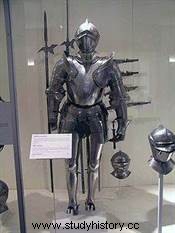 From the XIII
e
century one reinforces the protection of the body by applying on the chest the arms, the back of the metal plates intended to make more difficult the penetration of the weapons (a blow of an ax, a crossbow bolt can pierce a hauberk). This assembly acquires more rigidity to lead to the XV
e
century to the great white harness, complete armor made of articulated parts more efficient, heavier and more expensive!
From the XIII
e
century one reinforces the protection of the body by applying on the chest the arms, the back of the metal plates intended to make more difficult the penetration of the weapons (a blow of an ax, a crossbow bolt can pierce a hauberk). This assembly acquires more rigidity to lead to the XV
e
century to the great white harness, complete armor made of articulated parts more efficient, heavier and more expensive!
The knight's head is protected by a helmet, the "helmet" (from the Germanic helm ), simple hemispherical cap reinforced with a nasal from the XI th century then a fan or visagière pierced with blinkers. In the XII th century the helm is closed, cylindrical with two narrow horizontal opening sights, plus ventilation holes underneath. With the articulated visor we move towards the ''bassinet''. On the helmet, a crest bears the heraldic symbol of the knight, weighing down the helmet which is put on only at the time of combat.
The shield completes the protective gear. The almond-shaped Norman model is made of wood covered with leather but cumbersome, it is replaced by the targe of various shapes on which the knight's arms are painted.
The role of the horse
The warhorse, the steed (held by the dexter right hand of the squire) must be strong and resilient, able to charge at a gallop and withstand the press of the scrum. It is located above the palfrey, used for traveling and the roncin, pack horse wearing the warriors' barda. A knight must have several steeds because it is not uncommon to see his mount killed during battle, despite the mail covers supposed to protect him. The complete equipment of the knight costing considerable sums many knights do not have the means to face these expenses and seek the assistance of a powerful person by putting themselves at his service.
Hunting was experienced in the Middle Ages as training for war, both psychologically and physically, because the wildlife of medieval forests was capable of putting hunters to the test. the most determined, giving the opportunity to check their capacities of control and endurance. Warrior training begins with hunting along with riding and caring for horses.
The dubbing ceremony
 After a long and severe apprenticeship lived in the company of postulants of his age, the young squire is welcomed into the community knights. It is the greatest day of his life:that of "the dubbing" (which means in medieval French to equip )
After a long and severe apprenticeship lived in the company of postulants of his age, the young squire is welcomed into the community knights. It is the greatest day of his life:that of "the dubbing" (which means in medieval French to equip )
During this ceremony the young boy, thanks to the weapons he receives, crosses the threshold which separates the status of child from that of man. This ritual is described in the songs of gestures:
"so they dressed him in a very beautiful coat
And a green helm lace in his head
William girds his sword on the left side
Took a large shield by the hilt
Horse was good, the best on earth »
Before the handing over of arms, he will go through a gesture of sanctification:the colée, it is a blow given from the right palm of the adoubeur to the dubbed, symbolic test intended to verify that the young person is able to take a blow without flinching. Thus enthroned, the new knight must demonstrate horse jumping then launch at a gallop, shoot down with a spear in the center the dummy mounted on a pivot supposed to represent the enemy. Then comes the banquet where father uncle or lord show the generosity that is a sign of chivalry by entertaining his guests, without forgetting the poor, the jugglers and jesters who will go and praise the merits of their benefactor.
The spirit of chivalry in the Middle Ages
Chivalry has its code of honor, based on loyalty, courage and, very often, devotion to a lady (we speak of courtly love). Courageous in battle and loyal to his lord (or king, or lady), such is the image of the valiant knight.
However, the knight remains above all a warrior and the Church (like the people) often bears the brunt of private wars. This is why she tries to make moral the life and action of the knights who soon receive the mission of protecting those who pray and those who work. The knights are thus transformed into soldiers of God.
Knights' tournaments
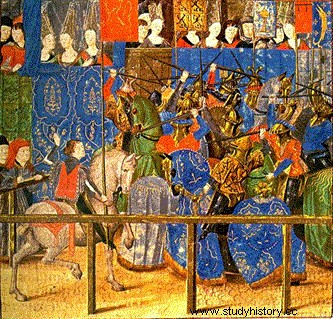 The newly knighted knight must travel the world to gain experience and prove his valour. He will find in the practice of tournaments the possibility of distinguishing themselves and making a name for themselves (vital thing for knights of modest origins) in order to find a protector to rise within feudal society. These tournaments are high points of chivalrous life, they serve as great maneuvers during which one trains for war.
The newly knighted knight must travel the world to gain experience and prove his valour. He will find in the practice of tournaments the possibility of distinguishing themselves and making a name for themselves (vital thing for knights of modest origins) in order to find a protector to rise within feudal society. These tournaments are high points of chivalrous life, they serve as great maneuvers during which one trains for war.
Two camps are formed according to affinities, family ties, provincial origins. At the signal, the two troops throw themselves against each other for a fight whose laws are those of a real battle, wounded and dead are picked up at the end of the confrontation, while the prisoners are held to ransom.
In these tournaments, beautiful ladies and young ladies crowd the stands, dressed in their finest finery to watch the fights. If one of them entrusts its colors to a fighter, this one will have to win or die. Life is hard for the knight!
The Christianization of Chivalry
Originally, the Church relied unambiguously on scripture (Matthew 26:52, “all who draw the sword shall perish by the sword” and "if a catechumen or a faithful wants to become a soldier, let him be dismissed because he has despised God", this condemnation has been perpetuated over the centuries, imposing severe penalties on any man who has killed one of his fellow men.
But the Church must take into account the necessities implied by an increasingly intimate coexistence with the State. The clergy had to disavow the militant incivility constituted by a declared anti-militarism when the Germanic invasions called into question the fate of the Empire. Then appears, through the mouth of Saint Augustine, the theory of the "just war".
"The soldier who kills the enemy is like the executioner who executes a criminal, it is not a sin to obey the law, he must to defend his fellow citizens to oppose force with force”.
Just war (and the mission to conduct it) becomes a justified reason because the duty of the Christian prince is to impose by terror and discipline what priests are powerless to prevail by word. In fact, the demands of Christian doctrine become, against the pagan or the infidel, a holy war.
At the end of the XI e century a formula will be put in place involving the adhesion of the men of war:the crusade. His ideology was already present in Spain and Italy in the IX th and X e centuries in the struggle between Islam and Christianity, but it takes on its full magnitude when the Holy See announces a new objective:Jerusalem and the deliverance from the tomb of Christ. The Christianization of chivalry is a phenomenon that has affected all of Christianity from the East to Northern Europe.
Bayard, a model knight
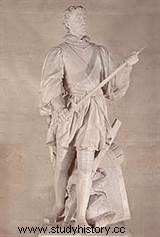 Entering the service of King Charles VIII, the Chevalier Bayard distinguished himself in 1495 at the Battle of Fornoue, during the Italian wars. In 1503, his heroic defense of the Garigliano bridge, alone against 200 Spaniards, to ensure the French retreat, earned him universal fame. His name also remains attached to the victory of Agnadel in 1509. After having decided on the capture of Bologna, he besieged Brescia with Gaston de Foix, but he was seriously wounded by a pike during the assault. /P>
Entering the service of King Charles VIII, the Chevalier Bayard distinguished himself in 1495 at the Battle of Fornoue, during the Italian wars. In 1503, his heroic defense of the Garigliano bridge, alone against 200 Spaniards, to ensure the French retreat, earned him universal fame. His name also remains attached to the victory of Agnadel in 1509. After having decided on the capture of Bologna, he besieged Brescia with Gaston de Foix, but he was seriously wounded by a pike during the assault. /P>
In Pavia threatened by the superior forces of the Venetians and the Swiss, he still managed to stop the enemy army with 36 men for two hours and received a serious wound in the shoulder . In 1513 he was in Artois invaded by the English and he was taken prisoner at Guinegatte (Day of the Spurs). Released shortly after, he was appointed lieutenant general of Dauphiné. He distinguished himself so brilliantly at Marignan in 1515 that King Francis I wanted to be knighted by his hands after the battle.
In 1522, despite prodigies of valor, he could not prevent the defeat of La Bicoque in Lombardy. Having received the mission to ensure the retreat of the French army after the defeat of Romagnano, he succeeded in making it pass the Sesia, but he was mortally wounded by an arquebus shot on April 30, 1524. Incarnation of courage and of the chivalrous spirit, He goes down in posterity as "the knight without fear and without reproach".
The Decline of the Knights
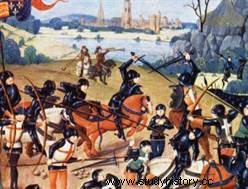 The fortified castle linked to the history of chivalry will disappear, powerless to resist repeated battery fire for long and the whole military architecture evolves. It is necessary to abandon the proud walls in favor of the grazing defenses "à la Vauban".
The fortified castle linked to the history of chivalry will disappear, powerless to resist repeated battery fire for long and the whole military architecture evolves. It is necessary to abandon the proud walls in favor of the grazing defenses "à la Vauban".
The setbacks of French chivalry during the great defeats of the Hundred Years' War (Crécy, Poitiers, Azincourt) show the rise in power of artillery and infantry .
Time and history have done their work, chivalry disappears as an institution but its ideals and model are still present. If chivalry is absent from society, is it for all that from the hearts of men?
To go further
- Knights and Chivalry in the Middle Ages:Daily Life, by Jean Flori. Fayard, 2013.
- La Chevalerie, by Dominique Barthélémy. Tempus, 2012.
- History of Chivalry, by Maurice Meuleau. Editions Ouest-France, 2014.
